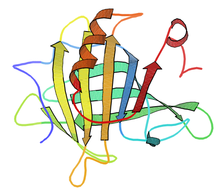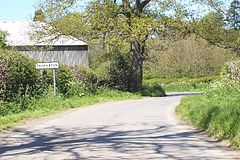베타락토글로불린
Beta-lactoglobulin| 베타락토글로불린 | |||||||
|---|---|---|---|---|---|---|---|
 | |||||||
| 식별자 | |||||||
| 유기체 | |||||||
| 기호. | BLG | ||||||
| 유니프로트 | P02754 | ||||||
| |||||||
β-락토글로불린(BLG)은 소와 양의 우유(약 3g/l)의 주요 유청 단백질이며, 많은 다른 포유류 종에도 존재한다. 주목할 만한 예외는 인간이다.그것의 구조, 특성, 생물학적 역할은 여러 [1][2][3][4]번 검토되었다.BLG는 우유 알레르겐으로 [5][6]여겨진다.
기능.
유장의 주요 단백질은 β-락토글로불린이며, 이어서 α-락토알부민(β-락토글로불린 65 65%, α-락토알부민 25 25%, 혈청알부민 8 8%, 기타 2 2%)이다.β-아미노글로불린은 리포칼린 단백질이며, 많은 소수성 분자와 결합할 수 있으며, 이는 그들의 수송에서 역할을 암시한다.β-아미노글로불린은 또한 시데로포어를[7] 통해 철분과 결합할 수 있고, 따라서 병원균과 싸우는 역할을 할 수 있는 것으로 나타났다.섭취 시 BLG는 복잡한 철분을 인간의 면역 세포로 운반할 수 있으며, 따라서 이러한 세포에 미량 영양분을 공급하고 면역 [8][9]내성에 참여합니다.인간 모유에는 [10]β-락토글로불린의 상동체가 결여되어 있다.
구조.
소의 주요 변종에는 A와 B라는 라벨이 붙어 있는 등 여러 변종이 확인되었다.풍부하고 쉽게 정화할 수 있기 때문에 다양한 생물물리학적 연구가 이루어지고 있습니다.그 구조는 X선 결정학에 의해 여러 번 결정되었으며, NMR.[11] β-락토글로불린은 유제품과 [12]가공에서 여러 가지 장점이 있을 수 있고 불리할 수 있기 때문에 식품업계에 직접적인 관심이 있다.
소 β-락토글로불린은 162개의 잔류물로 이루어진 비교적 작은 단백질로 18.4 kDa이다.생리학적 조건에서는 주로 이합체이지만 pH3에 대한 단량체와 분리되어 NMR을 [13]사용하여 결정된 고유 상태를 유지합니다. 반대로, β-락토글로불린은 다양한 자연 조건 하에서 4량체,[14] 8량체[15] 및 기타 다량체[16] 응집 형태에서도 발생합니다.
β-락토글로불린 용액은 자연 구조가 [17]응집될 정도로 불안정할 때 다양한 조건에서 겔을 형성한다.저pH 및 저이온 강도로 장시간 가열하면 단백질 분자가 긴 강섬유로 조립되는 투명한 '미세사슬'겔이 형성된다.
β-락토글로불린은 우유 껍질의 주요 성분으로 우유가 끓으면 응고되고 변성됩니다.변성되면 β-락토글로불린은 우유 표면에 얇은 젤라틴 형태의 막을 형성한다.
이 단백질의 접힘 중간체는 광분광학 및 변성제를 사용하여 연구할 수 있다.이러한 실험은 원어민 구조가 베타 시트라는 사실에도 불구하고 순수하게 알파 헬리크로 구성된 특이하지만 중요한 중간체를 보여준다.접힘 과정 [18]중 집계를 방지하기 위해 나선형 중간체에 진화가 선택되었을 것이다.
임상적 의의
우유는 알려진 [5]알레르겐이기 때문에 유럽연합의 제조업체는 라벨 표시가 EC 지침의 요건을 충족하는지 확인하기 위해 β-락토글로불린의 유무를 입증해야 한다.식품시험소는 효소연계면역흡수제 분석법을 사용하여 식품에서 β-락토글로불린을 식별하고 정량화할 수 있다.β-락토글로불린은 주요 알레르겐으로 간주되지만, 생유 섭취의 보호 효과는 유장 분획의 단백질 함량과 그에 따라 β-락토글로불린의 [19]단백질 함량에 따라 달라지는 것으로 나타났다.한편으론 알레르겐과 다른 한편으론 보호제인 이 큰 대비는 이제 미량 영양소를 운반하는 능력과 관련이 있다.β-락토글로불린이 미량영양소를 운반할 때 내성을 발휘하여 알레르기 발생을 방지하였다.하지만 로딩이 없어지자 알레르겐으로 [20][21][22]변했습니다.
미생물 트랜스글루타미나아제에 의한 β-락토글로불린의 실험실 중합은 IgE 매개 소의 우유 [23]알레르기를 가진 어린이 및 성인의 알레르기 유발성을 감소시킨다.
젖소 사육
2018년에 유전자 변형 소가 [6]재배되었다고 발표되었다.소들은 접합자 매개 결실 과정을 [6]통해 유전자를 제거하는 β-락토글로불린을 얻었다.
「 」를 참조해 주세요.
레퍼런스
- ^ Xiang L, Melton L, Leung KH (2019). "Interactions of β-Lactoglobulin With Small Molecules". In Varelis P, Melton L, Shahidi F (eds.). Encyclopedia of Food Chemistry. Vol. 2. Elsevier. pp. 560–565. doi:10.1016/B978-0-08-100596-5.21488-1. ISBN 9780128140451.
- ^ Sawyer L (1992). "Beta-lactoglobulin". In Fox PF, McSweeney PL (eds.). Advanced Dairy Chemistry: 1. Proteins. Elsevier Applied Science. pp. 141–190. doi:10.1007/978-1-4419-8602-3_7. ISBN 978-1-4419-8602-3.
- ^ Sawyer L, Kontopidis G (October 2000). "The core lipocalin, bovine beta-lactoglobulin". Biochimica et Biophysica Acta (BBA) - Protein Structure and Molecular Enzymology. 1482 (1–2): 136–48. doi:10.1016/s0167-4838(00)00160-6. PMID 11058756.
- ^ Kontopidis G, Holt C, Sawyer L (April 2004). "Invited review: beta-lactoglobulin: binding properties, structure, and function". Journal of Dairy Science. 87 (4): 785–96. doi:10.3168/jds.S0022-0302(04)73222-1. PMID 15259212.
- ^ a b 지침 2000/13/EC의 부속서 IIIa에 열거됨
- ^ a b c Wei, Jingwei; Wagner, Stefan; Maclean, Paul; Brophy, Brigid; Cole, Sally; Smolenski, Grant; Carlson, Dan F.; Fahrenkrug, Scott C.; Wells, David N.; Laible, Götz (2018-05-16). "Cattle with a precise, zygote-mediated deletion safely eliminate the major milk allergen beta-lactoglobulin". Scientific Reports. 8 (1): 7661. doi:10.1038/s41598-018-25654-8. ISSN 2045-2322. PMC 5955954. PMID 29769555.
- ^ Roth-Walter F, Pacios LF, Gomez-Casado C, Hofstetter G, Roth GA, Singer J, et al. (2014-01-01). "The major cow milk allergen Bos d 5 manipulates T-helper cells depending on its load with siderophore-bound iron". PLOS ONE. 9 (8): e104803. Bibcode:2014PLoSO...9j4803R. doi:10.1371/journal.pone.0104803. PMC 4130594. PMID 25117976.
- ^ Roth-Walter F, Afify SM, Pacios LF, Blokhuis BR, Redegeld F, Regner A, et al. (January 2021). "Cow's milk protein β-lactoglobulin confers resilience against allergy by targeting complexed iron into immune cells". The Journal of Allergy and Clinical Immunology. 147 (1): 321–334.e4. doi:10.1016/j.jaci.2020.05.023. PMID 32485264.
- ^ Afify SM, Pali-Schöll I, Hufnagl K, Hofstetter G, El-Bassuoni MA, Roth-Walter F, Jensen-Jarolim E (2021). "Bovine Holo-Beta-Lactoglobulin Cross-Protects Against Pollen Allergies in an Innate Manner in BALB/c Mice: Potential Model for the Farm Effect". Frontiers in Immunology. 12: 611474. doi:10.3389/fimmu.2021.611474. PMC 7977286. PMID 33746954.
- ^ Fiocchi A, Brozek J, Schünemann H, Bahna SL, von Berg A, Beyer K, et al. (April 2010). "World Allergy Organization (WAO) Diagnosis and Rationale for Action against Cow's Milk Allergy (DRACMA) Guidelines". The World Allergy Organization Journal. 3 (4): 57–161. doi:10.1097/WOX.0b013e3181defeb9. PMC 3488907. PMID 23268426.
- ^ PDB: 3BLG; Qin BY, Bewley MC, Creamer LK, Baker HM, Baker EN, Jameson GB (October 1998). "Structural basis of the Tanford transition of bovine beta-lactoglobulin". Biochemistry. 37 (40): 14014–23. doi:10.1021/bi981016t. PMID 9760236.
- ^ Jost R (1993). "Functional characteristics of dairy proteins". Trends in Food Science & Technology. 4 (9): 283–288. doi:10.1016/0924-2244(93)90071-H.
- ^ Uhrínová S, Smith MH, Jameson GB, Uhrín D, Sawyer L, Barlow PN (April 2000). "Structural changes accompanying pH-induced dissociation of the beta-lactoglobulin dimer". Biochemistry. 39 (13): 3565–74. doi:10.1021/bi992629o. PMID 10736155.
- ^ Timasheff SN, Townend R (1964). "Structure of the β-Lactoglobulin Tetramer". Nature. 203 (4944): 517–519. Bibcode:1964Natur.203..517T. doi:10.1038/203517a0. S2CID 4190604.
- ^ Gottschalk M, Nilsson H, Roos H, Halle B (November 2003). "Protein self-association in solution: the bovine beta -lactoglobulin dimer and octamer". Protein Science. 12 (11): 2404–11. doi:10.1110/ps.0305903. PMC 2366967. PMID 14573854.
- ^ Rizzuti B, Zappone B, De Santo MP, Guzzi R (January 2010). "Native beta-lactoglobulin self-assembles into a hexagonal columnar phase on a solid surface". Langmuir. 26 (2): 1090–5. doi:10.1021/la902464f. PMID 19877696.
- ^ Bromley EH, Krebs MR, Donald AM (2005). "Aggregation across the length-scales in beta-lactoglobulin". Faraday Discussions. 128: 13–27. doi:10.1039/b403014a. PMID 15658764.
- ^ Kuwajima K, Yamaya H, Sugai S (December 1996). "The burst-phase intermediate in the refolding of beta-lactoglobulin studied by stopped-flow circular dichroism and absorption spectroscopy". Journal of Molecular Biology. 264 (4): 806–22. doi:10.1006/jmbi.1996.0678. PMID 8980687.
- ^ Loss G, Apprich S, Waser M, Kneifel W, Genuneit J, Büchele G, et al. (October 2011). "The protective effect of farm milk consumption on childhood asthma and atopy: the GABRIELA study". The Journal of Allergy and Clinical Immunology. 128 (4): 766–773.e4. doi:10.1016/j.jaci.2011.07.048. PMID 21875744.
- ^ Roth-Walter F, Afify SM, Pacios LF, Blokhuis BR, Redegeld F, Regner A, et al. (January 2021). "Cow's milk protein β-lactoglobulin confers resilience against allergy by targeting complexed iron into immune cells". The Journal of Allergy and Clinical Immunology. 147 (1): 321–334.e4. doi:10.1016/j.jaci.2020.05.023. PMID 32485264.
- ^ Hufnagl K, Ghosh D, Wagner S, Fiocchi A, Dahdah L, Bianchini R, et al. (January 2018). "Retinoic acid prevents immunogenicity of milk lipocalin Bos d 5 through binding to its immunodominant T-cell epitope". Scientific Reports. 8 (1): 1598. Bibcode:2018NatSR...8.1598H. doi:10.1038/s41598-018-19883-0. PMC 5785490. PMID 29371615.
- ^ Afify SM, Pali-Schöll I, Hufnagl K, Hofstetter G, El-Bassuoni MA, Roth-Walter F, Jensen-Jarolim E (2021). "Bovine Holo-Beta-Lactoglobulin Cross-Protects Against Pollen Allergies in an Innate Manner in BALB/c Mice: Potential Model for the Farm Effect". Frontiers in Immunology. 12: 611474. doi:10.3389/fimmu.2021.611474. PMC 7977286. PMID 33746954.
- ^ Olivier CE, Lima RP, Pinto DG, Santos RA, Silva GK, Lorena SL, et al. (October 2012). "In search of a tolerance-induction strategy for cow's milk allergies: significant reduction of beta-lactoglobulin allergenicity via transglutaminase/cysteine polymerization". Clinics. 67 (10): 1171–9. doi:10.6061/clinics/2012(10)09. PMC 3460020. PMID 23070344.


